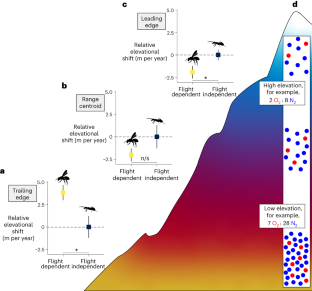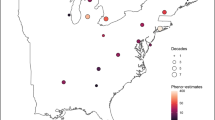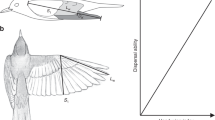Abstract
Climate change is forcing species to migrate to cooler temperatures at higher elevations, yet many taxa are dispersing slower than necessary. One yet-to-be-tested explanation for inadequate migration rates is that high-elevation environments pose physiological barriers to dispersal, particularly in species with high metabolic demands. By synthesizing across >800 species, we find evidence for metabolic constraints: upslope migration is slower in insects that rely on nature’s most expensive locomotor strategy—flight.
This is a preview of subscription content, access via your institution
Access options
Access Nature and 54 other Nature Portfolio journals
Get Nature+, our best-value online-access subscription
$29.99 / 30 days
cancel any time
Subscribe to this journal
Receive 12 print issues and online access
$209.00 per year
only $17.42 per issue
Buy this article
- Purchase on Springer Link
- Instant access to full article PDF
Prices may be subject to local taxes which are calculated during checkout

Similar content being viewed by others
Data availability
Data underlying this study can be accessed through the Dryad Digital Repository at https://doi.org/10.5061/dryad.kh18932bs (ref. 32).
Code availability
Code underlying this can be accessed through the Dryad Digital Repository at https://doi.org/10.5061/dryad.kh18932bs (ref. 32).
References
Pörtner, H. O. et al. Scientific outcome of the IPBES-IPCC co-sponsored workshop on biodiversity and climate change. (IPBES Secretariat, 2021).
Martin, R., da Silva, C. R. B., Moore, M. P. & Diamond, S. E. When will a changing climate outpace adaptive evolution? Wiley Interdiscip. Rev. Clim. (in the press).
Moore, M. P. et al. Sex-specific ornament evolution is a consistent feature of climatic adaptation across space and time in dragonflies. Proc. Natl Acad. Sci. USA 118, e2101458118 (2021).
Parmesan, C. Ecological and evolutionary responses to recent climate change. Annu. Rev. Ecol. Evol. Syst. 37, 637–669 (2006).
Chen, I. C., Hill, J. K., Ohlemüller, R., Roy, D. B. & Thomas, C. D. Rapid range shifts of species associated with high levels of climate warming. Science 333, 1024–1026 (2011).
Lenoir, J. et al. Species better track climate warming in the oceans than on land. Nat. Ecol. Evol. 4, 1044–1059 (2020).
Freeman, B. G., Song, Y., Feeley, K. J. & Zhu, K. Montane species track rising temperatures better in the tropics than in the temperate zone. Ecol. Lett. 24, 1697–1708 (2021).
Feeley, K. J., Rehm, E. & Stroud, J. T. There are many barriers to species migrations. Front. Biogeogr. 6, fb_22006 (2014).
Mamantov, M. A., Gibson‐Reinemer, D. K., Linck, E. B. & Sheldon, K. S. Climate‐driven range shifts of montane species vary with elevation. Glob. Ecol. Biogeogr. 30, 784–794 (2021).
Rehm, E. M., Olivas, P., Stroud, J. & Feeley, K. J. Losing your edge: climate change and the conservation value of range‐edge populations. Ecol. Evol. 5, 4315–4326 (2015).
Spence, A. R. & Tingley, M. W. The challenge of novel abiotic conditions for species undergoing climate‐induced range shifts. Ecography 43, 1571–1590 (2020).
Jacobsen, D. The dilemma of altitudinal shifts: caught between high temperature and low oxygen. Front. Ecol. Environ. 18, 211–218 (2020).
Altshuler, D. L. & Dudley, R. Adaptations to life at high elevation: an introduction to the symposium. Integr. Compar. Biol. 46, 3–4 (2006a).
Altshuler, D. L. & Dudley, R. The physiology and biomechanics of avian flight at high altitude. Integr. Compar. Biol. 46, 62–71 (2006b).
Reinhold, K. Energetically costly behaviour and the evolution of resting metabolic rate in insects. Funct. Ecol. 13, 217–224 (1999).
Videler, J. J. Avian Flight (Oxford Univ. Press, 2006).
Harrison, J. F., Greenlee, K. J. & Verberk, W. C. Functional hypoxia in insects: definition, assessment, and consequences for physiology, ecology, and evolution. Annu. Rev. Entomol. 63, 303–325 (2018).
Neate-Clegg, M. H. & Tingley, M. W. Building a mechanistic understanding of climate-driven elevational shifts in birds. PLOS Clim. 2, e0000174 (2023).
Radchuk, V. et al. Adaptive responses of animals to climate change are most likely insufficient. Nat. Commun. 10, 3109 (2019).
Seebacher, F., White, C. R. & Franklin, C. E. Physiological plasticity increases resilience of ectothermic animals to climate change. Nat. Clim. Change 5, 61–66 (2015).
Lack, J. B., Monette, M. J., Johanning, E. J., Sprengelmeyer, Q. D. & Pool, J. E. Decanalization of wing development accompanied the evolution of large wings in high-altitude Drosophila. Proc. Natl Acad. Sci. USA 113, 1014–1019 (2016).
Moore, M. P. & Khan, F. Relatively large wings facilitate life at higher elevations among Nearctic dragonflies. J. Anim. Ecol. 92, 1613–1621 (2023).
Freeman, B. G., Scholer, M. N., Ruiz-Gutierrez, V. & Fitzpatrick, J. W. Climate change causes upslope shifts and mountaintop extirpations in a tropical bird community. Proc. Natl Acad. Sci. USA 115, 11982–11987 (2018).
White, C. R. & Kearney, M. R. Determinants of inter-specific variation in basal metabolic rate. J. Comp. Phys. B 183, 1–26 (2013).
Zera, A. J. & Denno, R. F. Physiology and ecology of dispersal polymorphism in insects. Annu. Rev. Entomol. 42, 207–230 (1997).
Sánchez-Bayo, F. & Wyckhuys, K. A. Worldwide decline of entomofauna: a review of its drivers. Biol. Conserv. 232, 8–27 (2020).
Harvey, J. A. et al. International scientists formulate a roadmap for insect conservation and recovery. Nat. Ecol. Evol. 4, 174–176 (2020).
Perez, T. M., Stroud, J. T. & Feeley, K. J. Thermal trouble in the tropics. Science 351, 1392–1393 (2016).
Comte L., et al. BioShifts: a global geodatabase of climate-induced species redistribution over land and sea. Figshare https://doi.org/10.6084/m9.figshare.7413365 (2020).
Bates, D., Maechler, M., Bolker, B. & Walker, S. Fitting linear mixed-effects models using lme4. J. Stat. Softw. 67, 1–48 (2015).
Kuznetsova, A., Brockhoff, P. B. & Christensen, R. H. B. lmerTest: tests in linear mixed effects models. J. Stat. Softw. 82, 1–26 (2017).
Moore, M. P. Data from: upslope migration is slower in species with high physiological demands. Dryad Digital Repository https://doi.org/10.5061/dryad.kh18932bs (2023).
Acknowledgements
Support was generously provided by the University of Colorado Denver (to M.P.M. and J.S.) and Washington University in St. Louis and the Georgia Institute of Technology (to J.T.S.). Conversations with J. de Mayo, J. Grady and A. Lenard and input from three reviewers improved this study.
Author information
Authors and Affiliations
Contributions
M.P.M. designed the study. J.S. and M.P.M. collected the data. M.P.M. and J.T.S. analysed the data. M.P.M. and J.T.S. wrote the paper.
Corresponding author
Ethics declarations
Competing interests
The authors declare no competing interests.
Peer review
Peer review information
Nature Climate Change thanks Dean Jacobsen, Lourenço Martins and the other, anonymous, reviewer(s) for their contribution to the peer review of this work.
Additional information
Publisher’s note Springer Nature remains neutral with regard to jurisdictional claims in published maps and institutional affiliations.
Extended data
Rights and permissions
Springer Nature or its licensor (e.g. a society or other partner) holds exclusive rights to this article under a publishing agreement with the author(s) or other rightsholder(s); author self-archiving of the accepted manuscript version of this article is solely governed by the terms of such publishing agreement and applicable law.
About this article
Cite this article
Moore, M.P., Shaich, J. & Stroud, J.T. Upslope migration is slower in insects that depend on metabolically demanding flight. Nat. Clim. Chang. 13, 1063–1066 (2023). https://doi.org/10.1038/s41558-023-01794-2
Received:
Accepted:
Published:
Issue Date:
DOI: https://doi.org/10.1038/s41558-023-01794-2



